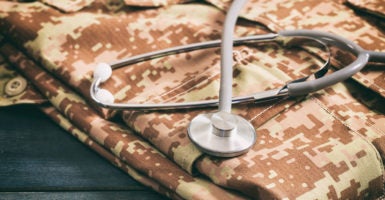Reducing inefficiency in government is always good, and reducing the size of government organizations generally promotes efficiency.
But not always. In some cases, cuts hurt effectiveness, and cutting the uniformed Public Health Service Commissioned Corps is one of those cases.
One of the favorite targets of would-be reformers seems always to be anyone wearing a uniform. Perhaps there have been too many bad movies about bumbling martinets in uniform and too much discussion of $2,000 toilet seats and $900 hammers.
But reformers should look deeper before unleashing their budgetary knives on the Public Health Service.
In a recent report titled “Delivering Government Solutions in the 21st Century: Reform Plan and Reorganization Recommendations,” the Office of Management and Budget provides three potential ways to reform the U.S. Public Health Service Commissioned Corps, one of the seven uniformed services.
The first idea—to reduce the size of the Commissioned Corps active-duty force from 6,500 to 4,000 officers—could have devastating effects on the function of the corps and its ability to provide medical support in key situations.
It almost goes without saying that when you cut 38 percent of an organization’s budget, it won’t be able to accomplish as much, and Americans have come to expect this level of commitment to protecting, promoting, and advancing the health of the nation.
Public Health Service deployments range from hurricanes and floods to outbreaks of Ebola and Zika to man-made emergencies such as mass shootings. If there is a health aspect of a federal response, Public Health Service members probably are responding.
Everyone currently serving in the Public Health Service’s Commissioned Corps could provide support during public health emergencies. There is added value in having uniformed service members on the front line of our response to catastrophic events. It also allows for prioritizing and shifting assets across the country.
This is the same reason why the National Guard activates individuals and units for natural disasters. Units from the Midwest help with hurricane response in Florida, from the West Coast to help with tornado response in Missouri, and from the East Coast to fight wild fires in California.
Civilianizing the corps would not save money, and in fact could cost more. Civilians cannot be directed to dangerous areas as can uniformed members unless they are incentivized. They also need overtime for inordinate hours of work, which is the norm in emergencies. They do more than emergency response.
The day-to-day jobs of U.S. Public Health Service members are in the clinical or managerial work, which underpins our health system. They fill roles in direct care for underserved populations, regulation of drugs and medical devices, and management of high-dollar health systems.
Instead of reducing the size of the Commissioned Corps, steps should be taken to consider increasing its size and capabilities.
The volume and size of natural disasters is rising. The nation needs a force that is trained and equipped to handle the health aspects involved with the myriad threats we face each year. The U.S. Public Health Service has been doing this since 1889.
Over the last few years, the Office of the Surgeon General, which oversees management of the Commissioned Corps, has taken steps to enforce standards for eligibility to serve and readiness to respond to public health emergencies. This is the right direction to take. To stunt that momentum with a reduction in force would have negative effects on recruitment and retention.
The second suggestion from the Office of Management and Budget is to create a Reserve Corps to match the reserve components of the other uniformed services. Such a program is needed. Many active-duty members provide clinical care for the Indian Health Service, Bureau of Prisons, or Coast Guard, and this makes their use elsewhere a tough call.
Additionally, the Affordable Care Act mistakenly got rid of the previous iteration of the reserve component of the Public Health Service. Many qualified and willing participants were stripped of their reserve commissions and barred from serving. These Americans are ready to volunteer to serve in their home or neighboring communities when disasters strike. The Department of Health and Human Services wants to harness that energy to serve and integrate it as a formal part of its response to public health emergencies.
The Affordable Care Act had lots of bad ideas. Eliminating the Reserve Corps was one of them.
The final Office of Management and Budget recommendation was a budgetary reform, which would shift retirement costs from the Office of the Assistant Secretary for Health of the Department of Health and Human Resources to the agencies that employ U.S. Public Health Service officers.
Presently, retirement pay and medical benefits are paid from a central account in Health and Human Services. This proposal would not save any money but would make agencies such as the Centers for Disease Control and Prevention, the Food and Drug Administration, and the National Institutes of Health think Public Health Service officers cost more than they do. This is a dollar-neutral suggestion that is cosmetic in effect.
The bottom line is that the Public Health Commissioned Corps is one of those organizations that actually serves a purpose. It provides for the most at-risk American communities every day and for us all in key emergencies.
This is not the place to shave off some pennies. This one is not broken and does not need to be fixed.





























